Yapeng Tian
High-Quality Sound Separation Across Diverse Categories via Visually-Guided Generative Modeling
Sep 26, 2025Abstract:We propose DAVIS, a Diffusion-based Audio-VIsual Separation framework that solves the audio-visual sound source separation task through generative learning. Existing methods typically frame sound separation as a mask-based regression problem, achieving significant progress. However, they face limitations in capturing the complex data distribution required for high-quality separation of sounds from diverse categories. In contrast, DAVIS circumvents these issues by leveraging potent generative modeling paradigms, specifically Denoising Diffusion Probabilistic Models (DDPM) and the more recent Flow Matching (FM), integrated within a specialized Separation U-Net architecture. Our framework operates by synthesizing the desired separated sound spectrograms directly from a noise distribution, conditioned concurrently on the mixed audio input and associated visual information. The inherent nature of its generative objective makes DAVIS particularly adept at producing high-quality sound separations for diverse sound categories. We present comparative evaluations of DAVIS, encompassing both its DDPM and Flow Matching variants, against leading methods on the standard AVE and MUSIC datasets. The results affirm that both variants surpass existing approaches in separation quality, highlighting the efficacy of our generative framework for tackling the audio-visual source separation task.
ANNIE: Be Careful of Your Robots
Sep 03, 2025Abstract:The integration of vision-language-action (VLA) models into embodied AI (EAI) robots is rapidly advancing their ability to perform complex, long-horizon tasks in humancentric environments. However, EAI systems introduce critical security risks: a compromised VLA model can directly translate adversarial perturbations on sensory input into unsafe physical actions. Traditional safety definitions and methodologies from the machine learning community are no longer sufficient. EAI systems raise new questions, such as what constitutes safety, how to measure it, and how to design effective attack and defense mechanisms in physically grounded, interactive settings. In this work, we present the first systematic study of adversarial safety attacks on embodied AI systems, grounded in ISO standards for human-robot interactions. We (1) formalize a principled taxonomy of safety violations (critical, dangerous, risky) based on physical constraints such as separation distance, velocity, and collision boundaries; (2) introduce ANNIEBench, a benchmark of nine safety-critical scenarios with 2,400 video-action sequences for evaluating embodied safety; and (3) ANNIE-Attack, a task-aware adversarial framework with an attack leader model that decomposes long-horizon goals into frame-level perturbations. Our evaluation across representative EAI models shows attack success rates exceeding 50% across all safety categories. We further demonstrate sparse and adaptive attack strategies and validate the real-world impact through physical robot experiments. These results expose a previously underexplored but highly consequential attack surface in embodied AI systems, highlighting the urgent need for security-driven defenses in the physical AI era. Code is available at https://github.com/RLCLab/Annie.
FreSca: Unveiling the Scaling Space in Diffusion Models
Apr 02, 2025Abstract:Diffusion models offer impressive controllability for image tasks, primarily through noise predictions that encode task-specific information and classifier-free guidance enabling adjustable scaling. This scaling mechanism implicitly defines a ``scaling space'' whose potential for fine-grained semantic manipulation remains underexplored. We investigate this space, starting with inversion-based editing where the difference between conditional/unconditional noise predictions carries key semantic information. Our core contribution stems from a Fourier analysis of noise predictions, revealing that its low- and high-frequency components evolve differently throughout diffusion. Based on this insight, we introduce FreSca, a straightforward method that applies guidance scaling independently to different frequency bands in the Fourier domain. FreSca demonstrably enhances existing image editing methods without retraining. Excitingly, its effectiveness extends to image understanding tasks such as depth estimation, yielding quantitative gains across multiple datasets.
Towards Online Multi-Modal Social Interaction Understanding
Mar 25, 2025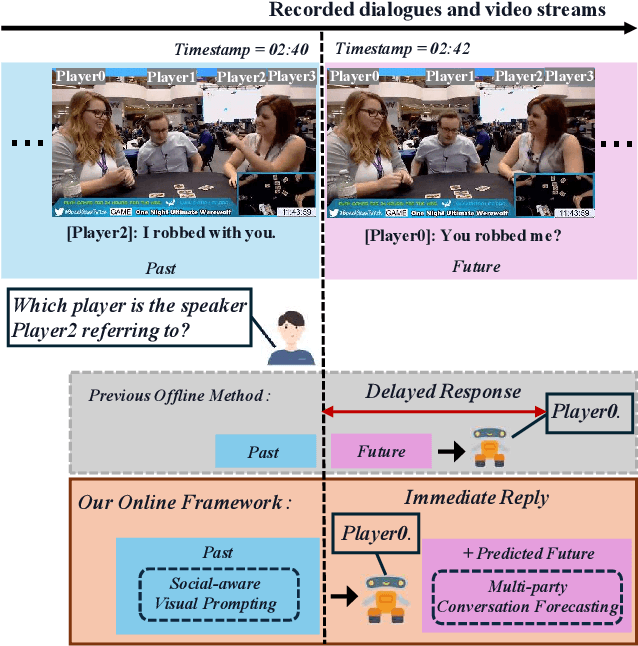
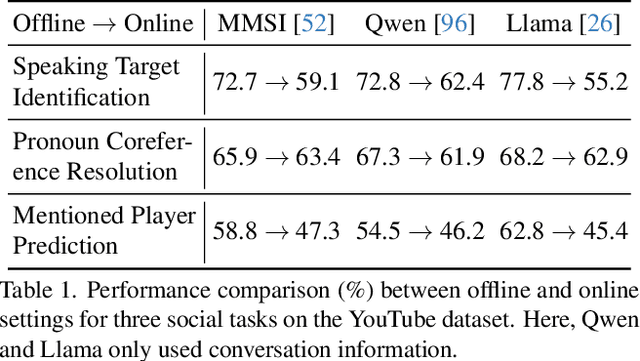
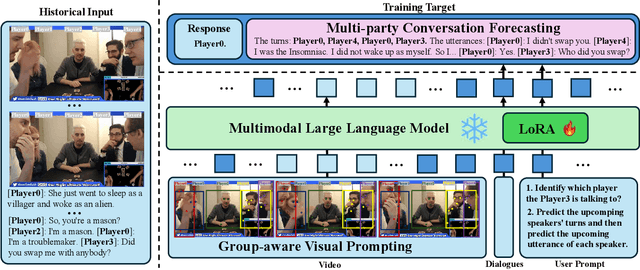
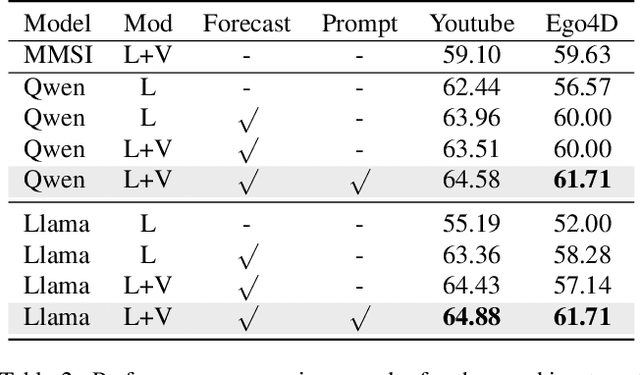
Abstract:Multimodal social interaction understanding (MMSI) is critical in human-robot interaction systems. In real-world scenarios, AI agents are required to provide real-time feedback. However, existing models often depend on both past and future contexts, which hinders them from applying to real-world problems. To bridge this gap, we propose an online MMSI setting, where the model must resolve MMSI tasks using only historical information, such as recorded dialogues and video streams. To address the challenges of missing the useful future context, we develop a novel framework, named Online-MMSI-VLM, that leverages two complementary strategies: multi-party conversation forecasting and social-aware visual prompting with multi-modal large language models. First, to enrich linguistic context, the multi-party conversation forecasting simulates potential future utterances in a coarse-to-fine manner, anticipating upcoming speaker turns and then generating fine-grained conversational details. Second, to effectively incorporate visual social cues like gaze and gesture, social-aware visual prompting highlights the social dynamics in video with bounding boxes and body keypoints for each person and frame. Extensive experiments on three tasks and two datasets demonstrate that our method achieves state-of-the-art performance and significantly outperforms baseline models, indicating its effectiveness on Online-MMSI. The code and pre-trained models will be publicly released at: https://github.com/Sampson-Lee/OnlineMMSI.
PRVQL: Progressive Knowledge-guided Refinement for Robust Egocentric Visual Query Localization
Feb 11, 2025Abstract:Egocentric visual query localization (EgoVQL) focuses on localizing the target of interest in space and time from first-person videos, given a visual query. Despite recent progressive, existing methods often struggle to handle severe object appearance changes and cluttering background in the video due to lacking sufficient target cues, leading to degradation. Addressing this, we introduce PRVQL, a novel Progressive knowledge-guided Refinement framework for EgoVQL. The core is to continuously exploit target-relevant knowledge directly from videos and utilize it as guidance to refine both query and video features for improving target localization. Our PRVQL contains multiple processing stages. The target knowledge from one stage, comprising appearance and spatial knowledge extracted via two specially designed knowledge learning modules, are utilized as guidance to refine the query and videos features for the next stage, which are used to generate more accurate knowledge for further feature refinement. With such a progressive process, target knowledge in PRVQL can be gradually improved, which, in turn, leads to better refined query and video features for localization in the final stage. Compared to previous methods, our PRVQL, besides the given object cues, enjoys additional crucial target information from a video as guidance to refine features, and hence enhances EgoVQL in complicated scenes. In our experiments on challenging Ego4D, PRVQL achieves state-of-the-art result and largely surpasses other methods, showing its efficacy. Our code, model and results will be released at https://github.com/fb-reps/PRVQL.
Joint Co-Speech Gesture and Expressive Talking Face Generation using Diffusion with Adapters
Dec 18, 2024



Abstract:Recent advances in co-speech gesture and talking head generation have been impressive, yet most methods focus on only one of the two tasks. Those that attempt to generate both often rely on separate models or network modules, increasing training complexity and ignoring the inherent relationship between face and body movements. To address the challenges, in this paper, we propose a novel model architecture that jointly generates face and body motions within a single network. This approach leverages shared weights between modalities, facilitated by adapters that enable adaptation to a common latent space. Our experiments demonstrate that the proposed framework not only maintains state-of-the-art co-speech gesture and talking head generation performance but also significantly reduces the number of parameters required.
Modality-Inconsistent Continual Learning of Multimodal Large Language Models
Dec 17, 2024



Abstract:In this paper, we introduce Modality-Inconsistent Continual Learning (MICL), a new continual learning scenario for Multimodal Large Language Models (MLLMs) that involves tasks with inconsistent modalities (image, audio, or video) and varying task types (captioning or question-answering). Unlike existing vision-only or modality-incremental settings, MICL combines modality and task type shifts, both of which drive catastrophic forgetting. To address these challenges, we propose MoInCL, which employs a Pseudo Targets Generation Module to mitigate forgetting caused by task type shifts in previously seen modalities. It also incorporates Instruction-based Knowledge Distillation to preserve the model's ability to handle previously learned modalities when new ones are introduced. We benchmark MICL using a total of six tasks and conduct experiments to validate the effectiveness of our proposed MoInCL. The experimental results highlight the superiority of MoInCL, showing significant improvements over representative and state-of-the-art continual learning baselines.
VinTAGe: Joint Video and Text Conditioning for Holistic Audio Generation
Dec 14, 2024



Abstract:Recent advances in audio generation have focused on text-to-audio (T2A) and video-to-audio (V2A) tasks. However, T2A or V2A methods cannot generate holistic sounds (onscreen and off-screen). This is because T2A cannot generate sounds aligning with onscreen objects, while V2A cannot generate semantically complete (offscreen sounds missing). In this work, we address the task of holistic audio generation: given a video and a text prompt, we aim to generate both onscreen and offscreen sounds that are temporally synchronized with the video and semantically aligned with text and video. Previous approaches for joint text and video-to-audio generation often suffer from modality bias, favoring one modality over the other. To overcome this limitation, we introduce VinTAGe, a flow-based transformer model that jointly considers text and video to guide audio generation. Our framework comprises two key components: a Visual-Text Encoder and a Joint VT-SiT model. To reduce modality bias and improve generation quality, we employ pretrained uni-modal text-to-audio and video-to-audio generation models for additional guidance. Due to the lack of appropriate benchmarks, we also introduce VinTAGe-Bench, a dataset of 636 video-text-audio pairs containing both onscreen and offscreen sounds. Our comprehensive experiments on VinTAGe-Bench demonstrate that joint text and visual interaction is necessary for holistic audio generation. Furthermore, VinTAGe achieves state-of-the-art results on the VGGSound benchmark. Our source code and pre-trained models will be released. Demo is available at: https://www.youtube.com/watch?v=QmqWhUjPkJI.
Efficient Self-Improvement in Multimodal Large Language Models: A Model-Level Judge-Free Approach
Nov 26, 2024



Abstract:Self-improvement in multimodal large language models (MLLMs) is crucial for enhancing their reliability and robustness. However, current methods often rely heavily on MLLMs themselves as judges, leading to high computational costs and potential pitfalls like reward hacking and model collapse. This paper introduces a novel, model-level judge-free self-improvement framework. Our approach employs a controlled feedback mechanism while eliminating the need for MLLMs in the verification loop. We generate preference learning pairs using a controllable hallucination mechanism and optimize data quality by leveraging lightweight, contrastive language-image encoders to evaluate and reverse pairs when necessary. Evaluations across public benchmarks and our newly introduced IC dataset designed to challenge hallucination control demonstrate that our model outperforms conventional techniques. We achieve superior precision and recall with significantly lower computational demands. This method offers an efficient pathway to scalable self-improvement in MLLMs, balancing performance gains with reduced resource requirements.
CATCH: Complementary Adaptive Token-level Contrastive Decoding to Mitigate Hallucinations in LVLMs
Nov 19, 2024


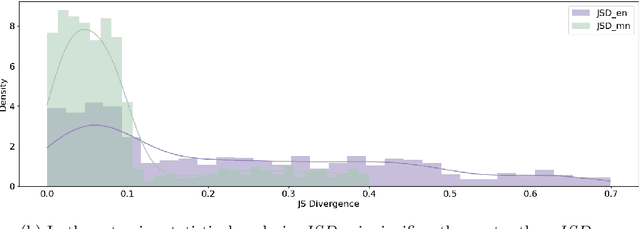
Abstract:Large Vision-Language Model (LVLM) systems have demonstrated impressive vision-language reasoning capabilities but suffer from pervasive and severe hallucination issues, posing significant risks in critical domains such as healthcare and autonomous systems. Despite previous efforts to mitigate hallucinations, a persistent issue remains: visual defect from vision-language misalignment, creating a bottleneck in visual processing capacity. To address this challenge, we develop Complementary Adaptive Token-level Contrastive Decoding to Mitigate Hallucinations in LVLMs (CATCH), based on the Information Bottleneck theory. CATCH introduces Complementary Visual Decoupling (CVD) for visual information separation, Non-Visual Screening (NVS) for hallucination detection, and Adaptive Token-level Contrastive Decoding (ATCD) for hallucination mitigation. CATCH addresses issues related to visual defects that cause diminished fine-grained feature perception and cumulative hallucinations in open-ended scenarios. It is applicable to various visual question-answering tasks without requiring any specific data or prior knowledge, and generalizes robustly to new tasks without additional training, opening new possibilities for advancing LVLM in various challenging applications.
 Add to Chrome
Add to Chrome Add to Firefox
Add to Firefox Add to Edge
Add to Edge